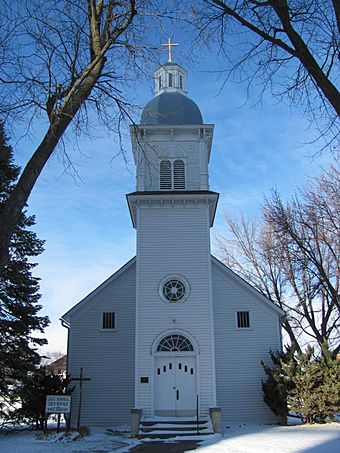Saints Peter and Paul Catholic Church (Pocahontas, Iowa) facts for kids
Quick facts for kids |
|
|
Saints Peter and Paul Catholic Church
|
|
 |
|
| Location | 16 2nd Ave., NW, Pocahontas, Iowa |
|---|---|
| Area | less than one acre |
| Built | 1882 |
| Built by | Will Hubel |
| Architectural style | Italianate Greek Revival |
| NRHP reference No. | 94000086 |
| Added to NRHP | March 1, 1994 |
Saints Peter and Paul Catholic Church was once a church for the Roman Catholic Diocese of Sioux City. This old building is in Pocahontas, Iowa, United States. It served the Bohemian community living in the Pocahontas area. The church was added to the National Register of Historic Places in 1994.
Contents
History of the Church
Early Days and First Services
The first Catholic Mass in Pocahontas happened in 1875. It was led by Rev. T.M. Lenahan from Fort Dodge, Iowa. Church services were held sometimes in a schoolhouse until 1881. That year, Pocahontas became a mission of St. Patrick's Church. This church was located on Lizard Creek in Webster County, Iowa. Rev. Mathew Norton began holding Mass once a month. At that time, churches in this area belonged to the Roman Catholic Archdiocese of Dubuque.
Building the Church
In 1882, Warrick Price gave three acres of land for a church and cemetery. This land was east of town. Will Hubbel designed the church building. He also led the construction work. Men from the local Bohemian community helped build it. Hubbel built many early buildings in Pocahontas.
The church's altar was made by Charles Andera of Spillville, Iowa. Mary Payer donated the altar. She also gave a painting of St. Peter and St. Paul. This painting was made in Bohemia. The church bells were named Agnes and Joseph. They were brought all the way from St. Louis, Missouri.
Growth and Changes
The first full-time pastor, Rev. J.P. Bronz, served the church from 1891 to 1895. The rectory, which is the priest's house, was built during this time. In 1894, the church building was moved. It went from Calvary Cemetery to its current spot west of the town center. The church was made bigger and updated the next year. A school was started by the church in 1896. Sisters of St. Francis of the Holy Family from Dubuque, Iowa taught there.
A Church for the Bohemian Community
In 1901, Sacred Heart Parish was started in Pocahontas. This church was for German and Irish families. The school moved with them. Saints Peter and Paul then became a "national parish" for the Bohemian immigrant community. It joined the Sioux City diocese when it was created in 1902.
It was hard for the bishop to find priests who spoke Bohemian. Rev. Michael J. Kolvek was the pastor from 1923 to 1938. Rev. John Turza was pastor from 1954 to 1957. Other pastors could not speak the language.
Modern Updates and Closing
The church was renovated in 1957. New floors, pews, an altar, and a communion rail were added. It was redecorated in 1964. A few years later, more changes were made. These changes followed new ideas from the Second Vatican Council. The altar was moved so the priest could face the people.
By 1975, Pocahontas did not need two churches. Bishop Frank Henry Greteman combined Saints Peter and Paul and Sacred Heart. The new church was called Resurrection of Our Lord. Both church buildings were used for services at first. Saints Peter and Paul Church closed permanently in 1983. It was listed on the National Register of Historic Places in 1994. The last Mass in the church was held in 1997.
Church Architecture
Building Design and Style
The church building is made of wood. It is about 90 feet long and 32 feet wide. It has a tall, three-story tower. The building shows a mix of two styles: Italianate and Greek Revival.
You can see the Italianate style in the round-arched windows. Also, there are pairs of decorative brackets on the bell tower. The Greek Revival style is seen in the fan-shaped window above the main door. It is also in the decorative flat columns on the corners of the building. The top part of the tower also has a fan-shaped design. A small, decorative structure called a lantern sits at the very top of the tower.
Why This Church is Important
Saints Peter and Paul Church is important for several reasons. It was the first Catholic church in Pocahontas County, Iowa. It also has a strong connection to the Bohemian people who settled there. The church building is special because of its Italianate and Greek Revival design. It is also linked to its builder, Will Hubbel. This church is the last wood-frame church building left in Pocahontas. It is one of the last ones in the whole county.



